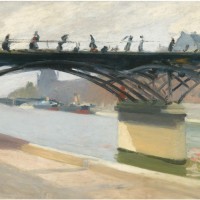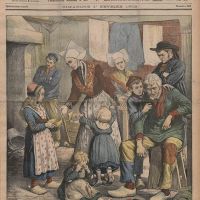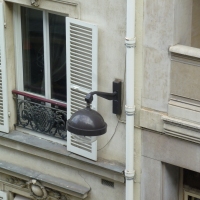Sooner or later, we know, we will end up having lunch at the Cantine in the BHV (Bazar de l’Hôtel de Ville). It’s central. It’s inexpensive. The food is good. The view from the big windows is magnificent. And of all the Paris department stores, it’s the most approachable. It’s not as big as Galeries Lafayette, nor as beautiful as Printemps, nor as trendy as Le Bon Marché. But it’s a reliable place to find what you want, from lunch to lightbulbs to luggage to lingerie.
This time, we were entranced by the illustrations on the cafeteria walls. They were pictures of culinary tools, paired with the objects from which they took their names. A mandoline (for slicing) with the musical instrument. A chinois (cone-shaped sieve) and a Chinese hat. A diable (a small casserole dish) and a picture of the devil. An araignée (skimmer) and a spiderweb. About a dozen pairs in all.
The series had been created for BHV by Sabine Forget, a Paris artist who does delightful watercolours and pen-and-ink sketches. As we ate our poached salmon and salad, we studied her pictures, enjoyed the wordplay, and added some new terms to our French vocabulary.
After lunch, we took the escalators back down to the ground floor and walked out to the street. I began to notice things about the BHV I hadn’t registered before.The back of the building doesn’t resemble the front, and the front doesn’t resemble, well, anything much. There’s a Belle Epoque dome at one end and a plain, squarish entry at the other end and in between is a series of traditional-looking buildings with more modern storeys on top of some of them.
The photograph I took at the time didn’t capture that very well, so here is a Google Street view, taken from the end away from the domed entry.
The other side of the store looks more like a purpose-built grand magasin, with big windows and imposing columns. Odd.
The satellite buildings nearby (the pet store, menswear, bicycles) offer unexpected treats – a growing green wall, for example, and a second café in a pleasant courtyard near menswear. But they are not connected to the store architecturally. The overall impression is that there is no overall impression. This is an architectural mishmash of a store.
It got me thinking about department stores in general. They are one of the distinct cultural institutions in Paris and they seem to be holding their own there, even as those in other countries struggle to survive. When I was a child growing up in Toronto, the two big department stores were the T. Eaton Company and Robert Simpson’s – imposing downtown buildings with brass-trimmed revolving doors (I got my arm caught in one when I was about six years old and caused quite a stir when I had to be extricated) as well as complicated elevators operated by smartly uniformed women in white gloves who handled the controls and announced the floors (“Third Floor: Shoes, Lingerie”). Both companies have long since been bought out by others (Sears, Hudson Bay) and both are losing ground to monotonous suburban big-box stores with fluorescent strip lighting, industrial-style shelving, and cheap merchandise.
French department stores seem to have fared somewhat better, although many have perished along the way. Who now remembers that Les Deux Magots was a department store before it became a café frequented by existentialist authors? Or that Pygmalion was the name of a Paris store before it was a play by George Bernard Shaw? Will La Samaritaine ever reopen in some semblance of its former glory? Do any traces remain of the Grand Bazar de la Rue de Rennes underneath the dreary exterior of the current Fnac outlet? And why does no one remember the flashiest of them all, the glorious Grands Magasins Dufayel, with its dome and searchlight, which was once a huge tourist draw and is now largely forgotten?
Somehow, as these have vanished over the years, the Bazar de l’Hotel de Ville has persisted.
The founder, Xavier Ruel, started small. He had a business selling small items and trinkets from carts, and his employees fanned out around the city, selling their wares on the sidewalks. During the disruptions of the Haussmann period, when half the city was being knocked down and new construction was everywhere, mobile carts made sense. But Ruel discovered that the salesman who parked his barrow opposite City Hall was earning many times what the other employees brought in. Location, location, location. Ruel decided to rent the ground floor of a building in that spot for a little boutique he called the Bazar Parisien.
In 1860 or so (accounts differ), his business got a boost from royalty. The story goes that Napoléon III’s wife, the Empress Eugénie, was passing in front of the sales carts on the rue de Rivoli when the horses pulling her carriage took fright and bolted. Ruel, who was standing nearby, had the presence of mind to catch the reins and calm the horses. The Empress later sent him a sizable sum of money to show her gratitude.
The reward allowed Ruel to expand his operations until eventually, his store occupied the entire block. He renamed it the Bazar Napoléon in honour of the Emperor (husband of his benefactress). But with the fall of the Empire in 1871, that name became politically incorrect. So Ruel again renamed his establishment, this time after the Hotel de Ville across the road – which itself burned down in the 1871 conflict and had to be rebuilt.
Ruel died in 1900, at the age of 78, by which time his department store was a going concern with 800 employees. The business passed to his nephew, since he had no sons.
At that point, the store still occupied the various buildings that Ruel had acquired piecemeal over time. The other grands magasins had flagship stores created by the “starchitects” of the time. Why not BHV?
According to the architectural histories I have found, some improvements were made in 1903-04 and then a new building was created in 1912-13 by the architect Auguste Roy. But when you look at the building, it it hard to figure out who did what.
Was it Roy who designed the grand dome on the corner and the purpose-built section on the north side? Whatever happened in 1912-13, it seems to have been a retrofit, not a new building. This would explain why the place lacks a glorious atrium and glass roof, which characterize many of its competitors, and why the interior is often hard to navigate. The photo below shows the juxtaposition of two of the building styles that make up the BHV.

It also appears that Auguste Roy was far from being a “starchitect” of the calibre of Paul Sédille who created Printemps, or Gustave Rives, who made the Grands Magasins Dufayel into a glittering tourist draw. Roy and some colleagues had won first prize to design a primary school once. He’d done an apartment building or two. Hardly a sought-after name-brand architect.
Despite some belle époque flourishes, the BHV cannot really be considered an elegant venue. The interior ceilings are low and covered with acoustic tile, and the elevators can be hard to find. Nevertheless, it is the go-to place for hardware, kitchenware, toys, stationery, and art supplies. We’ve bought everything there from clothes to colanders to Sophie la Girafe (for a grandchild).
Today, thanks to consolidation, it is owned by the same folks who run the Galeries Lafayette and Monoprix, but it maintains its own personality. And there are still carts out front, selling toys and trinkets – Xavier Ruel would approve.
The basement hardware department is legendary, but alas, the little bar in the form of a handyman’s workshop, where we used to stop for a glass of wine after negotiating the maze of tools and DIY supplies, has gone.
So now we head upstairs to the cafeteria with its big windows and affordable poached salmon, and look out over City Hall and the river.
Nineteenth-century department stores used to offer a home away from home for shoppers (with everything from lending libraries to writing rooms with monogrammed stationery to children’s playrooms). For us, the BHV is that welcoming space where we can alight temporarily in the middle of a bustling foreign city and feel at home.
Text and photographs by Philippa Campsie


































Maybe one of the reasons for the survival of BHV is its ability to adjust to the needs of its shoppers. When I first came to Paris for sources for paintings (1993) I was told to go to BHV for supplies as it had one of the best sections for serious artist’s supplies and indeed it did. But five or six years later the department was made smaller and most of the supplies were for crafts and less serious art dabblers and I went to Sennelier instead.
For the do-it-yourself-er in Paris the BHV is indispensable and a real treat for non-internet browsing.
Pingback: Le Bazar de l'Hôtel de Ville | Exploring the Paris food scene | Scoop.it
You have to love the French for having a workshop bar in a hardware department. What a shame it’s gone!
Another wonderful post. Great info about the origins of the store. Le BHV is, indeed, a Parisian institution. Back in the day, it was also famous among locals for having some of the most unpleasant sales staff available in the retail industry – I can attest to that as I lived in Paris for 10 years! They have done a great job at keeping up with the times, and modernizing inside, something their competitor La Samaritaine was not so good at doing (they eventually closed down…) My favorite section is still the hardware department downstairs. That is what really sets them apart from the other Parisian department stores. Veronique (French Girl in Seattle)
Oh, I do love your blog – it is so wonderfully untouristy, if you know what I mean. I love just wandering the streets of Paris, looking at doors, and windows, and roofs, and visiting the little gardens I stumble across, and learning about the people who lived and worked there in the past. You really make me feel as if I was there…
love…BHV…always seem to end up there…maybe it reminds me of Eatons and Simpson back in the day…good tip…5th floor in the kids clothes section…great washrooms..never a line up…and the picture of the housewares dept is exactly where I’ve spent much time….and yes the basement…a complete maze but somehow worth it…I don’t think I’d feel like I’d been to Paris without a stop at BHV….
note…on a hot day in Paris the top floor of the BHV is actually the coolest…don’t ask me why but that’s where we found a place to cool off…amongst the furniture.
I,too, have felt at home wandering the aisles of some of the department stores of Paris.
Enjoyed your words and photos.
Pingback: The Paris Blog: Paris, France Expat Tips & Resources »Blog Archive » Lunch at BHV